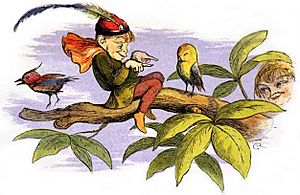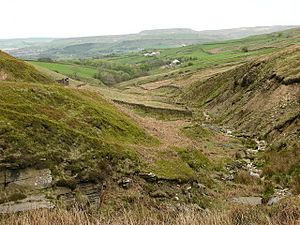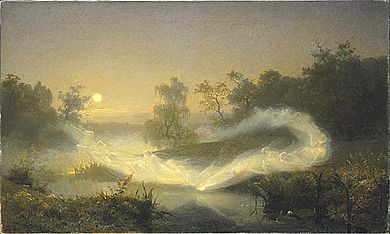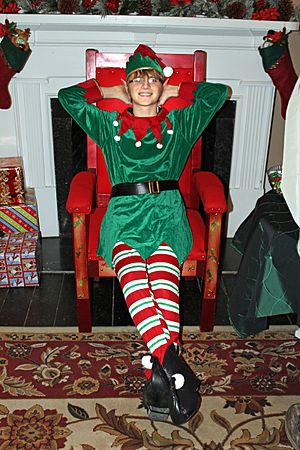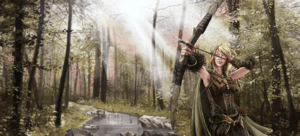Elf facts for kids
An elf is a magical creature often found in stories and folklore. People usually think of elves as good beings who help nature. They are sometimes linked to old beliefs about nature and magic.
Elves are often described in different ways. Sometimes they are tall, like humans, but with a stronger build. Other times, like in The Lord of the Rings, they are human-sized or even taller. Elves are also known for their long, pointy ears.
In many fantasy stories today, elves are one of the main groups of creatures. They often appear alongside dwarves and humans. Sometimes, they are part of a bigger group that includes creatures like orcs, goblins, trolls, and giants.
The word elf comes from old languages spoken in places like Germany and Scandinavia. It might have originally meant "white being." We learn about early ideas of elves from old writings, often from Christian times. These old stories connect elves to gods, magic, beauty, and sometimes even causing illness.
Contents
Elves in Old Stories
In old Norse stories, elves often appeared as female spirits. They were said to live in hills and piles of stones. In Sweden, these elves, called älvor, were described as very beautiful girls. They lived in the forest with an elf king.
People believed that elves danced in meadows, especially at night or on misty mornings. Where they danced, they left circles called älvdanser (elf dances) or älvringar (elf circles). These circles were often fairy rings made of small mushrooms.
There was another kind of elf circle too. A local historian named Anne Marie Hellström described them:
- ...on lake shores, where the forest met the lake, you could find elf circles.
- They were round places where the grass had been flattened like a floor.
- Elves had danced there.
- It was thought to be dangerous to step on such a place.
- You could even become ill if you disturbed anything there.
Stories say that if a human watched the elves dance, time would pass differently. Only a few hours might seem to go by, but many years would have passed in the real world. Being invited or tricked into an elf dance is a common idea from old Scandinavian songs.
Not all elves in old stories were young and beautiful. In a Swedish folktale, an old but beautiful elvish woman helps a young girl. People saw her as belonging to the "subterraneans," meaning creatures living underground.
Elves in Modern Culture
Christmas Elves
As countries became more industrial and education spread, old folklore about elves became less common. But as popular culture grew, elves were imagined in new ways. This was often based on old books and stories from the Romantic period.
In the 1800s, Christmas traditions in America began to take shape. A famous poem from 1823, "A Visit from St. Nicholas" (also known as "'Twas the Night before Christmas"), even called Santa Claus "a right jolly old elf."
However, it was Santa's little helpers who became known as "Santa's elves." These helpers were partly inspired by folktales like The Elves and the Shoemaker. A German-American cartoonist named Thomas Nast helped make this idea popular.
Today, in many countries like the US, Canada, UK, and Ireland, children's stories about Santa Claus include small, quick elves. They often wear green clothes, have pointy ears, long noses, and pointy hats. These elves are Santa's helpers. They make toys in a workshop at the North Pole. The idea of elves helping Santa is still very popular, as seen in the movie Elf.
Elves in Fantasy Stories
The fantasy genre, which includes many popular books and games, grew out of 1800s Romanticism. During this time, scholars like Andrew Lang and the Grimm brothers collected and retold old fairy tales.
One important early fantasy book was The King of Elfland's Daughter by Lord Dunsany in 1924. Later, the Elves of Middle-earth were very important in J. R. R. Tolkien's books, especially The Silmarillion and The Lord of the Rings. Tolkien's elves had a huge impact on all fantasy writing that came after.
Since the 1960s, elves in fantasy stories and role-playing games (like Dungeons & Dragons) have often been like Tolkien's elves. They might speak an elvish language. These fantasy elves are often shown as:
- Wiser and more beautiful than humans.
- Having sharper senses and better hearing or sight.
- Gifted in magic.
- Mentally sharp and clever.
- Lovers of nature, art, and song.
- Often skilled archers.
- A common feature is their pointed ears.
In stories where elves are the main characters, like The Silmarillion or the comic book series Elfquest, elves show many different human-like behaviors. They are mainly different because of their superhuman physical powers. But in stories focused more on humans, like The Lord of the Rings, elves often remain powerful, sometimes mysterious, outsiders.
Images for kids
-
Title page of Daemonologie by James VI and I, a book that tried to explain old beliefs using Christian ideas.
-
Thomas the Rhymer in Walter Scott's Minstrelsy of the Scottish Border.
-
An illustration of Shakespeare's A Midsummer Night's Dream by Arthur Rackham.
-
Little älvor, playing with Tomtebobarnen. From Children of the Forest (1910) by Swedish author and illustrator Elsa Beskow.
See also
 In Spanish: Elfo para niños
In Spanish: Elfo para niños


